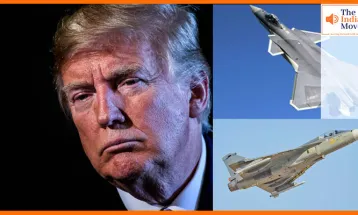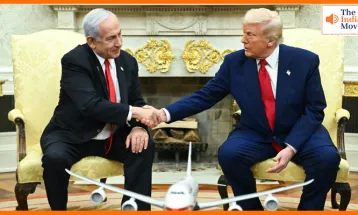
Trump's New US Tariffs: Who Will Pay & What Comes Next?
-
 Chhavi
Chhavi
- April 2, 2025
Three Big Unknowns Ahead of Trump's 'Liberation Day' Tariffs
Donald Trump says tariffs are coming. He has made that clear. But which tariffs, and when? Since he took office, import taxes have increased rapidly, fueling concerns of a growing US trade war.
He has already raised duties on Chinese imports, steel, aluminum, and some products from Canada and Mexico. Higher import taxes on cars will take effect this week. Now, he is set to announce a broader US tariffs plan that has been in the works for weeks.
The White House calls it "Liberation Day." So what should we expect?
Read this also: Taiwan Under Threat: China’s War Drills Near Taiwan

How Big Are the Tariffs?
The White House has not shared exact numbers. Analysts suggest different possibilities. During his campaign, Trump proposed a 10% tariff on all imports. At times, he mentioned raising it to 20% or even 60% on imports from China.
Once in office, he introduced the idea of "reciprocal" tariffs. "If they charge us, we charge them," he said in February. Later, the White House said the plan would also consider unfair trade practices, such as the Value Added Tax (VAT).
Businesses and politicians are rushing to figure out how much these new import taxes will cost. European trade officials expect a double-digit tariff. Earlier this year, Trump said he planned to hit EU goods with a 25% import tax.
Which Countries Will Be Affected?
The administration has not confirmed details, but Trump hinted the US tariffs could apply to "all countries."
That crushed hopes for tariff exemptions. The UK, for instance, had hoped to avoid the US trade tariffs. Some countries may still negotiate deals, but it is unclear how broad or selective the tariffs will be.
Last month, Treasury Secretary Scott Bessent said they were focusing on the "Dirty 15"—the top 15% of US trade partners that impose unfair tariffs or restrictions on US manufacturing and exports. The Office of the US Trade Representative listed Argentina, Australia, Brazil, Canada, China, the EU, India, Indonesia, Japan, Korea, Malaysia, Mexico, Russia, Saudi Arabia, South Africa, Switzerland, Taiwan, Thailand, Turkey, the UK, and Vietnam as key targets.
Trump has criticized major global trade partners, including Canada and the EU. "Friend has been, oftentimes, much worse than foe," he said last week.
What Impact Will the Tariffs Have?
Tariffs are taxes on imports. But who really pays?
Technically, US businesses importing goods will face the charges. If tariffs take effect immediately, as White House spokeswoman Karoline Leavitt suggested, companies will have to adjust quickly.
Many businesses will try to reduce costs—by switching suppliers, negotiating better deals, or raising prices. But higher prices could drive away customers. Some companies are already preparing to increase prices, which could fuel inflation and slow economic growth.
Trump says companies can avoid tariffs by manufacturing in the US. But moving operations is neither quick nor cheap. Setting up factories takes time and money.
If global trade partners retaliate, economies could suffer. Currency fluctuations, supply chain disruptions, and increased import costs could make the situation even harder to predict.

What's Happening on April 2?
Trump is set to announce the new US tariffs at 4 p.m. in the White House Rose Garden. He calls them "Liberation Day" tariffs, aimed at reducing America’s dependence on foreign goods and countering unfair trade policies.
Starting April 2, the delayed 25% tariffs on Canadian and Mexican imports could take effect. A 25% tariff on imports will also apply to countries buying oil or gas from Venezuela. Auto imports will face the same tax, beginning Thursday.
How is Thailand Responding?
Thailand plans to reduce its trade surplus with the US by importing more energy and food. Officials estimate that if US tariffs increase by 11%, Thai exporters could lose about $8 billion.
Prime Minister Paetongtarn Shinawatra's government is preparing a strategy to limit the economic impact. "We will take a holistic approach in trade talks to reduce the impact on our economy," said Commerce Ministry official Vuttikrai Leewiraphan.
Last year, Thailand's trade surplus with the US was $45 billion. Now, the country is bracing for a financial hit.
The Bigger Picture
The new US tariffs could disrupt global trade. Some businesses may shut down, while others could move production. American consumers may see higher prices on many products.
Countries hit by the import taxes might retaliate, sparking a trade war. This could slow global economic growth, increase unemployment, and create market instability.
While Trump believes the tariffs will boost US manufacturing, economists warn they could backfire. If companies struggle with higher costs, they may cut jobs or raise prices, making life harder for American consumers.
In the coming days, businesses, governments, and consumers will watch closely to see how these US trade tariffs unfold—and how they reshape global trade policies.
For more articles visit The India Moves
Comment / Reply From
You May Also Like
महत्वपूर्ण खबर
Categories
- देश (1665)
- अपराध (131)
- मनोरंजन (279)
- शहर और राज्य (333)
- दुनिया (703)
- खेल (343)
- धर्म - कर्म (523)
- व्यवसाय (163)
- राजनीति (535)
- हेल्थ (164)
- महिला जगत (47)
- राजस्थान (407)
- हरियाणा (53)
- मध्य प्रदेश (52)
- उत्तर प्रदेश (187)
- दिल्ली (212)
- महाराष्ट्र (129)
- बिहार (108)
- टेक्नोलॉजी (164)
- न्यूज़ (82)
- मौसम (85)
- शिक्षा (105)
- नुस्खे (70)
- राशिफल (312)
- वीडियो (1023)
- पंजाब (27)
- ट्रैवल (15)
- अन्य (29)
- जम्मू कश्मीर (67)
- उत्तराखंड (1)
- तेलंगाना (0)
- छत्तीसगढ (0)
- गुजरात (1)
- हिमाचल प्रदेश (0)
- पश्चिम बंगाल (1)
- असम (0)
Vote / Poll
क्या राजस्थान मे बेरोजगारी का मुद्दा खत्म हो चुका है ..












